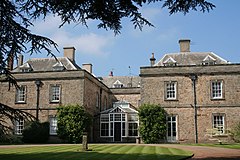Melbourne Hall
| Melbourne Hall | |
|---|---|

Melbourne Hall main entrance
|
|
| General information | |
| Town or city | Melbourne, Derbyshire |
| Country | England |
| Coordinates | 52°49′13″N 1°25′27″W / 52.8202°N 1.42420°WCoordinates: 52°49′13″N 1°25′27″W / 52.8202°N 1.42420°W |
| Construction started | 12th century |
| Client | Sir John Coke |
| Design and construction | |
| Engineer | Richard Shepherd |
Melbourne Hall, Derbyshire, England was once the seat of the Victorian Prime Minister William Lamb, 2nd Viscount Melbourne, and thus is the origin of the name of the city of Melbourne, Australia. The house is now the seat of Lord and Lady Ralph Kerr and is open to the public. The house is a Grade II* listed building; more than twenty features in the grounds are Grade I listed.
Melbourne, a manor that had belonged to the bishops of Carlisle in the twelfth century, was partly rebuilt in 1629–31 for Sir John Coke by a Derbyshire mason, Richard Shepherd. In 1692 it was inherited by Thomas Coke (1675–1727), a gentleman architect in the golden age of English amateur architecture, who laid out the formal gardens that survive, with some professional assistance from Henry Wise, between about 1696 and 1706: there are avenues, a parterre, a yew walk that has become a yew tunnel, basins and fountains, and lead and stone sculpture, much of it supplied by John Nost. Coke travelled in the Netherlands and he turned to Nost, the famous statuary born in the Austrian Netherlands, with premises in Haymarket, London, who provided lead figures of amorini, vases, baskets of flowers and mythological figures, still identifiable at Melbourne, and most notably the lead "Vase of the Seasons" (1705), that is one of the finest examples of Baroque sculpture in lead in an English garden. Nost also provided a number of chimneypieces in the house as well as for Sir Thomas's London house in St. James's Place, one of which came to £50. At the sale of Nost's effects, Sir Thomas purchased his copy of Serlio's Five Books of Architecture, English'd by Robert Peake, which is still in the Library.
Among fine wrought iron made for the grounds at Melbourne by Robert Bakewell is the wrought-iron arbour known as the "birdcage".
Though he drew up a plan for remodelling the sixteenth and seventeenth-century house and had the west wing rebuilt by Francis Smith of Warwick it remained to his son, G. L. Coke to rebuild the east front, facing the garden, and adjust the south front, in 1743–44, to a design by William Smith, the son of Francis Smith. His design for a gatehouse, built "according to his Honour's Draught" was built by Smith of Warwick but dismantled before the end of the eighteenth century. Unidentified alterations undertaken in 1720–21 were carried out by the builder William Gilks of Burton-on-Trent. The figure of George Lewis Coke remains an ambiguous one. Some believe that he was never at Melbourne after he left for a foreign tour in his late teens.
...
Wikipedia
